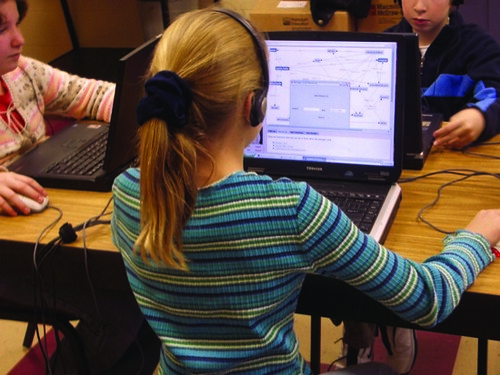
Middle school students teach a cartoon character and then test her comprehension. Photo by Jason Tan
Anyone who has ever helped children with homework knows how much they resist checking their answers. Now a new animated computer program created by Vanderbilt engineers is showing students that self-checking is an effective–and enjoyable–way to learn.
Teachers in Nashville and California public school classrooms are using a program called “Betty’s Brain” to teach fifth- and sixth-grade students about river ecosystems. But Betty’s Brain teaches much more than middle school science content. It also teaches students how to learn.
Supported by $2.5 million in joint funding from the National Science Foundation and the U.S. Department of Education, a team of researchers from Vanderbilt and Stanford universities–headed by Gautam Biswas, Vanderbilt professor of electrical engineering and computer science–has demonstrated that students learn science content much better by using “Betty’s Brain.” Studies at middle schools in Nashville and California show that the students also carry over that learning into new subjects, practice monitoring themselves along the way, and have fun in the process.
Using a simplified visual representation called a concept map, the students teach a cartoon character named Betty about river-ecosystem processes, such as the food chain, photosynthesis and the waste cycle. Then they test her to see if she has learned her lesson. Unless the students periodically check whether Betty understands the concepts and their relations, she will refuse to take the test. In checking her, the students are really checking themselves and discovering that self-monitoring is an important strategy that applies to all learning situations.
“In order to teach, they first have to learn,” Biswas says. “Students are much more motivated to monitor someone else, but in the process they are actually monitoring themselves. It’s more entertaining for the students, and they feel a sense of responsibility. Because they are teaching her, they want her to do well.”
At the bottom of the computer screen is an animated cartoon of Betty. A shared concept map, which represents what Betty and the student have learned, is in the middle of the screen. Using speech and animation processes, Betty can demonstrate how she reasons and answers questions with that information.
“The program’s strongest effect is on student reasoning processes,” says Rod Roscoe, a research associate in computer science whose field is the psychology of learning. When students are introduced to new science concepts weeks or months after using “Betty’s Brain,” studies show that they carry over those learning strategies in mastering the new material.
Student tools include Mr. Davis’ Library, which contains text explaining the concepts, and simulations that provide animated pictures of what happens to fish in a river if food, sunlight, microorganisms and wastes increase or decrease.
The system gives science teachers tools for incorporating the program into regular classroom activities. Teachers have access to the students’ concept maps, which can be projected on a screen for classroom study and discussion.
The teacher can view each student’s progress, identify where problems are occurring, and receive suggestions on how best to help each individual. “It helps struggling students see that they are not alone, and they learn from each other,” says teacher Sharon Melton.
Biswas, whose field of expertise includes modeling and analysis of complex systems, describes himself as “an engineer or computer scientist who knows cognitive science.” Several years ago he helped design the successful “Adventures of Jasper Woodbury” interactive videodisc series, which focused on mathematics and problem solving. Now he and his colleagues from the fields of cognitive science and science education are working on developing software to teach reading to elementary school students and introductory computer science to college students. V
Learn more about “Betty’s Brain”: www.teachableagents.org